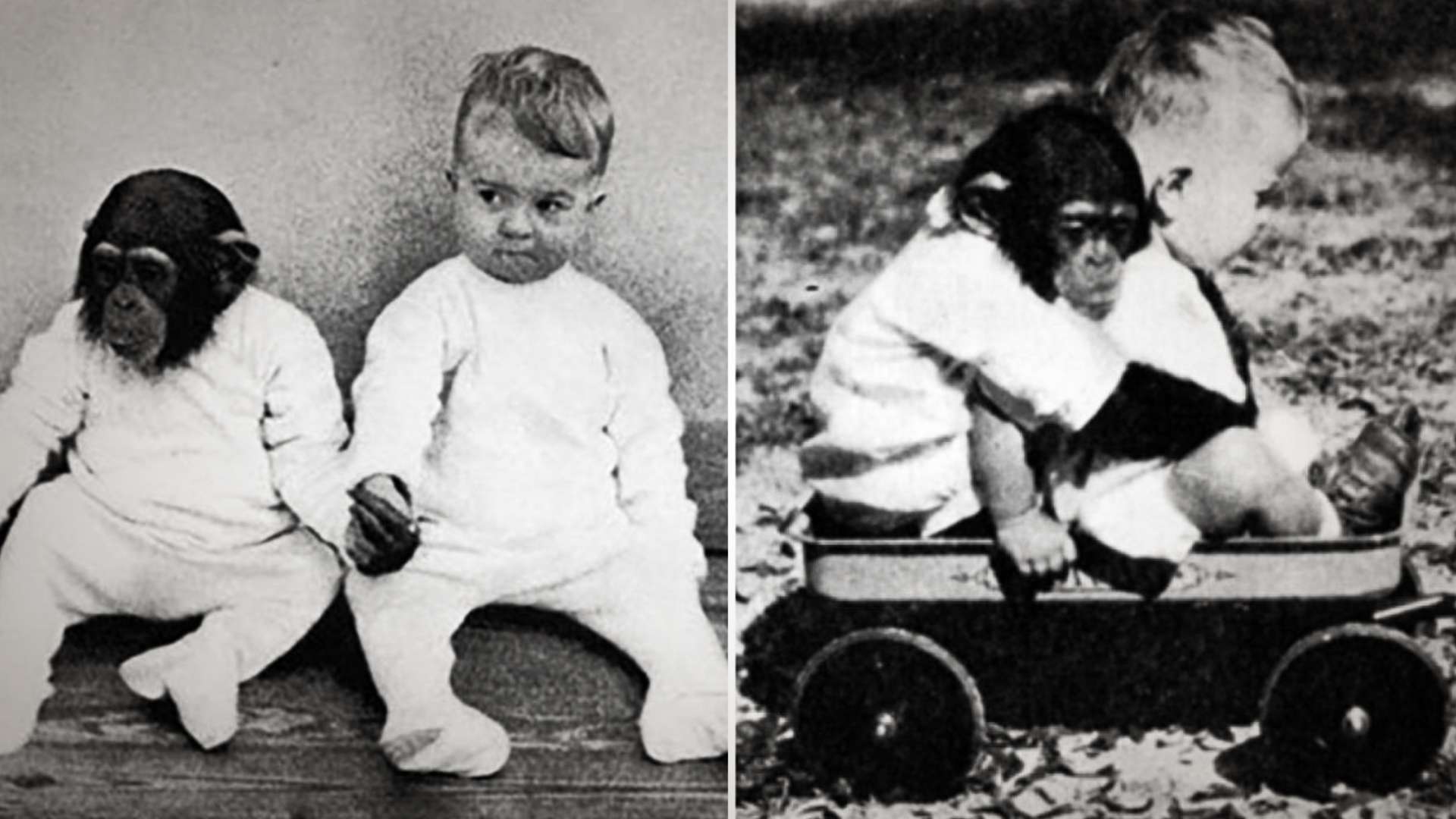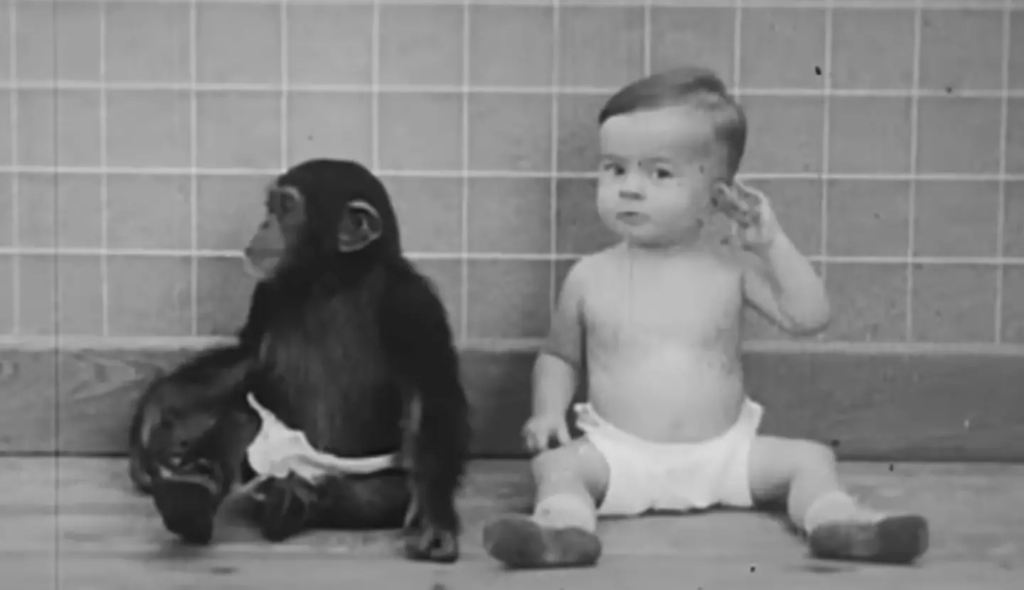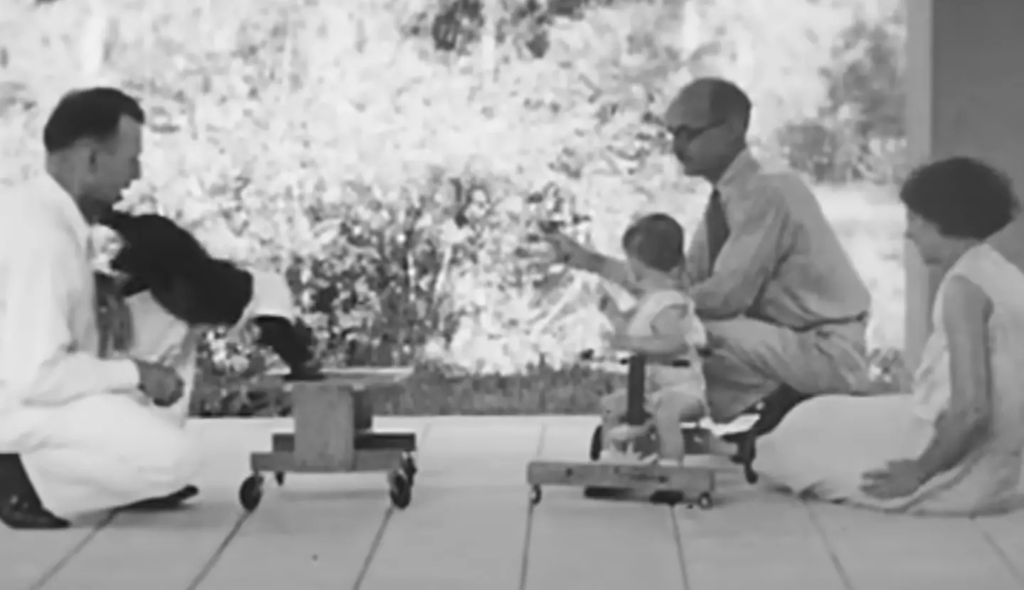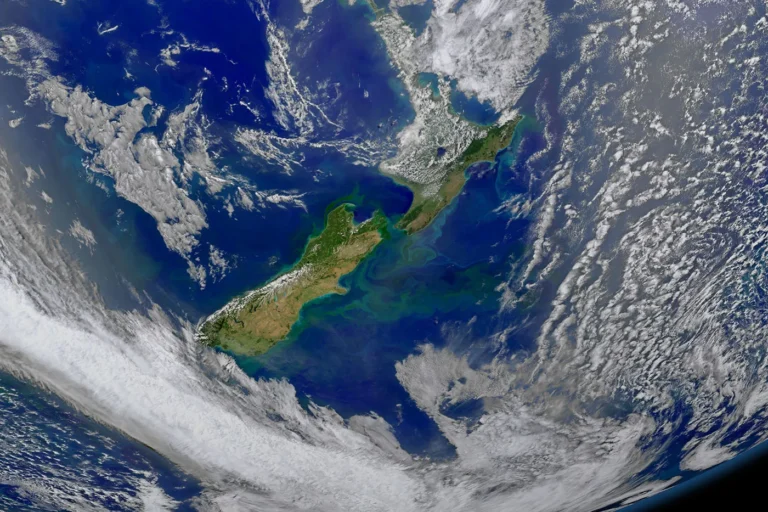Shocking Footage Reveals the Disturbing Experiment Where a Baby Was Raised Alongside a Chimpanzee – The Forgotten Tragedy of the 1930s Study

A Terrifying Look at a Forgotten 1930s Experiment
In 1931, a psychologist’s controversial experiment raised an infant boy alongside a chimpanzee, and the results were both disturbing and thought-provoking. This peculiar study aimed to explore how a chimpanzee, raised in a human environment, would develop compared to a human child. The footage captured during the experiment, which has resurfaced recently, paints a chilling picture of the human-animal bond and raises unsettling questions about nature, nurture, and the limits of human intervention.
This post dives into the unsettling details of this experiment, its aftermath, and what it teaches us about the ethical boundaries of scientific inquiry. Learn more about the study’s origins here.
The Origins of the Experiment: A Dangerous Desire to Understand Nature vs. Nurture
Winthrop Niles Kellogg, a comparative psychologist, had long been fascinated by the concept of “wild children”—children who were raised with minimal or no human contact. His curiosity about how environment shapes development was the catalyst for this radical experiment. Rather than studying a human child left in the wilderness, Kellogg decided to take the opposite approach: bringing a chimpanzee into a human environment. Learn more about wild children and their implications in psychological research.

On June 26, 1931, Kellogg and his wife brought home a baby chimpanzee named Gua, who was just a few months old. Gua would be raised alongside the Kellogg’s’ own infant son, Donald, who was nine months old at the time. The goal of the experiment, as described in the Psychological Record, was to determine how environment could shape cognitive development. Could a chimpanzee develop human-like behaviours if raised in a human household? And conversely, could a human child develop chimp-like behaviours in a similar setting?
The Kellogg’s’ approach was ground-breaking, but it was also controversial. Find out more about the debate on nature vs. nurture here.
The Experiment: Raising a Baby and a Chimpanzee as Siblings
From the outset, the Kellogg’s immersed Gua and Donald in identical environments. The couple dedicated over 12 hours a day to conducting a variety of experiments designed to test both the chimp and the child’s problem-solving abilities, strength, and obedience. They observed the babies’ reactions to sound, their responses to challenges, and the way they interacted with each other.
In one striking experiment, the Kellogg’s tested the babies’ and chimp’s responses to loud noises by firing a gun behind them. The results were striking. Gua, the chimpanzee, immediately climbed onto Kellogg for comfort, showing visible distress. Donald, on the other hand, was startled but seemed more curious than frightened.
Despite the psychological implications of the experiment, the footage taken during this time provides a chilling glimpse into the reality of the study. Watch the video footage here.
The Challenges Faced by Gua and Donald
As the study progressed, both Gua and Donald showed signs of development in different areas, but it became clear that their progress was not equal. While Gua showed remarkable progress in some areas, she also faced a “cognitive wall” where she could not go beyond certain limitations inherent to her species. The experiment, as described in the Psychological Record, revealed that environment could influence development, but genetic inheritance still played a critical role in shaping behaviour.
The experiment also highlighted a deeply unsettling aspect: Donald began imitating Gua’s chimpanzee sounds, leading to concerns about his language development. The Kellogg’s concluded that the lack of human speech development in Donald, paired with his mimicking of Gua’s noises, might have been the reason the study was ultimately abandoned.
Discover the psychological concept of cognitive limitations in animals and humans.
Social Media Reactions: What People Are Saying About the Chilling Experiment
The resurfacing of footage from this disturbing 1930s experiment has sparked a wide range of reactions across social media. Many users have expressed shock and disbelief at the unethical nature of the study, while others have questioned the scientific curiosity that led to such a controversial experiment.
Here are some notable reactions:
Twitter Post:
“I can’t believe this ‘experiment’ was ever allowed. The ethical implications are staggering. We’ve come a long way, but we need to keep these lessons in mind.”
Read more on Twitter.
Facebook Post:
“This experiment shows just how far human curiosity can go—and why we need ethical boundaries in research. Imagine the trauma for both the baby and the chimpanzee.”
Join the conversation on Facebook.
Reddit Discussion:
“The fact that Donald started mimicking Gua’s chimp noises makes me question everything I know about nature vs. nurture. Is this the result of an unhealthy environment or just biological limitations?”
Read the full discussion on Reddit.
Instagram Post:
“The footage from this 1930s experiment is mind-boggling. Human rights and animal welfare should always come before scientific curiosity. #EthicsInScience #Psychology”
See the Instagram post here.
A Disturbing Conclusion: The End of the Study and Its Aftermath
The Kellogg’s abruptly ended the experiment in March 1932, after just nine months. The reasons for the study’s termination remain unclear. According to the Psychological Record, Gua was returned to a primate colony after a gradual rehabilitation process, but the Kellogg’s offered little explanation for why they ceased their research.
One significant detail that emerged after the study ended was the emotional impact it had on Donald. He began to mimic Gua’s chimpanzee-like behaviours, which led to concerns that the experiment was negatively influencing his development. Additionally, Gua’s increasing strength and size posed a potential danger to Donald’s well-being. Read more about the ethical concerns surrounding animal testing in psychological research.

The study’s findings, though limited, shed light on the complex interplay between genetic predispositions and environmental influences. The results were mixed, and the experiment was widely regarded as a failure in its attempt to demonstrate that an animal could develop human-like behaviour through upbringing alone.
Ethical Questions and Controversies: Should Such Experiments Be Conducted?
The experiment raises profound ethical questions. Should researchers subject animals or children to such extreme conditions in the name of science? While the study provided valuable insights into developmental psychology, it also serves as a reminder of the importance of considering the moral implications of scientific experimentation.
Today, such experiments would be met with significant ethical and legal restrictions, especially with respect to animal welfare and child development. Laws and regulations governing animal testing and child psychology have come a long way since the 1930s. Learn more about ethical considerations in psychological research.
Final Thoughts: The Lasting Impact of the Experiment
The 1931 Kellogg experiment remains a shocking chapter in the history of psychological research. It stands as a cautionary tale about the limits of scientific curiosity and the potential dangers of disregarding ethical considerations. While it was ground-breaking in some ways, it was also deeply troubling, especially in its treatment of both the chimpanzee and the infant.
Despite the experiment’s ethical shortcomings, it nonetheless contributed to our understanding of cognitive development and the role that genetics and environment play in shaping behaviour. In retrospect, it serves as a reminder of how far we’ve come in terms of research ethics and the respect we must give to both human and animal subjects in scientific studies.
Explore the evolution of psychological research ethics.
Conclusion
In conclusion, the 1931 experiment by Winthrop Niles Kellogg remains a controversial and unsettling piece of scientific history. It offers a window into a time when the boundaries of research were pushed without regard for the ethical implications. Today, as we continue to explore the complexities of human and animal behaviour, we must always remember the lessons of this dark chapter in psychological research. As technology advances, we must ensure that scientific curiosity is always tempered by a commitment to ethical responsibility.
Read more about the ethical dilemmas in psychological experimentation.
Featured Image Credit: YouTube/A/V Geeks 16mm Films






